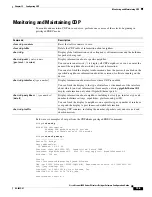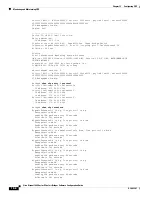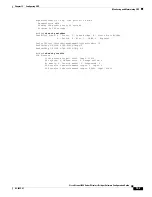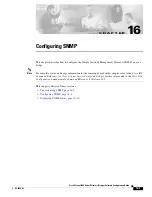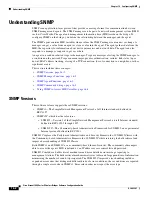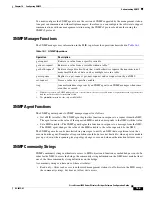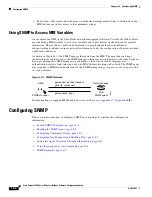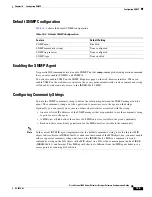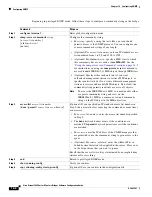
16-4
Cisco Aironet 1400 Series Wireless Bridges Software Configuration Guide
OL-4059-01
Chapter 16 Configuring SNMP
Configuring SNMP
•
Read-write—Gives read and write access to authorized management stations to all objects in the
MIB, but does not allow access to the community strings
Using SNMP to Access MIB Variables
An example of an NMS is the CiscoWorks network management software. CiscoWorks 2000 software
uses the bridge MIB variables to set device variables and to poll devices on the network for specific
information. The results of a poll can be displayed as a graph and analyzed to troubleshoot
internetworking problems, increase network performance, verify the configuration of devices, monitor
traffic loads, and more.
As shown in
Figure 16-1
, the SNMP agent gathers data from the MIB. The agent can send traps
(notification of certain events) to the SNMP manager, which receives and processes the traps. Traps are
messages alerting the SNMP manager to a condition on the network such as improper user
authentication, restarts, link status (up or down), MAC address tracking, and so forth. The SNMP agent
also responds to MIB-related queries sent by the SNMP manager in
get-request
,
get-next-request
, and
set-request
format.
Figure 16-1 SNMP Network
For information on supported MIBs and how to access them, see
Appendix C, “Supported MIBs.”
Configuring SNMP
This section describes how to configure SNMP on your bridge. It contains this configuration
information:
•
Default SNMP Configuration, page 16-5
•
Enabling the SNMP Agent, page 16-5
•
Configuring Community Strings, page 16-5
•
Configuring Trap Managers and Enabling Traps, page 16-7
•
Setting the Agent Contact and Location Information, page 16-9
•
Using the snmp-server view Command, page 16-9
•
SNMP Examples, page 16-9
get-request, get-next-request,
get-bulk, set-request
Network device
get-response, traps
81949
SNMP manager
NMS
MIB
SNMP agent








